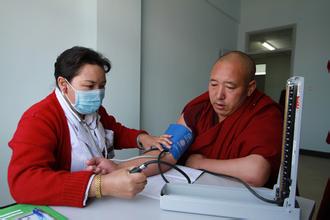Clinics are available within Tibetan monasteries and nunneries

Lhasa is bathed in warm sunshine in winter. Several nuns are queuing up to receive their daily medicines. A sunbeam slants through the window and shines on Chokyi, a monastic doctor busy with dispensing medicines.
Located on the Ngachen Mountain with an elevation of some 4,700 meters in the northern suburb of Lhasa, Miqiongri Nunnery belongs to Gelug Sect of Tibetan Buddhism. In the past, it had neither monastic doctor nor clinic. The health center of Ngachen Township sent a doctor to see patients in the nunnery every other month.
In case of sudden diseases, the nuns’ life and health couldn’t be ensured. To this end, the health bureau of Chengguan District of Lhasa decided to train Chokyi, a nun in the nunnery who ever studied medicine this year. Recently, Chokyi returned to the nunnery after the training and established a clinic in the nunnery, becoming a doctor there.
In the new clinic, stethoscope, blood pressure meter, finger pulse oximeter and other equipment are neatly placed on the table, and the Chinese patent medicine, Western medicine and Tibetan medicine kept in the cabinet. Besides the basic knowledge of Western medicine such as dosage and injection, Chokyi also learned to operate the physiotherapy device and plateau oxygenator.
“These two devices are particularly useful. The nuns are very happy,” said Chokyi.
At present, there are over 1,700 sites for religious activities of various kinds in Tibet, with over 46,000 lamas and nuns. The lamas and nuns in some remote agricultural and pastoral areas still have a tough life.
From 2011, the Tibet Autonomous Region put forward that financial subsidies would be given to comprehensively improve the infrastructure and cultural facilities of monasteries, with a view to letting every monastery have access to tap water, electricity and road and provide newspaper, book house, radio, TV and films for their inhabitants.
On this basis, various localities of Tibet improved the living conditions of lamas and nuns in accordance with their respective reality. In recent years, Lhasa City has implemented a regulation that each monastery should have a bathhouse, dining room, garbage storage pool, greenhouse and a medical worker.
“The clinic and monastic doctor can not only provide medical treatment for the nuns in the nunnery but also help the pilgrims to a certain extent,” Chokyi said, “the monastic doctor can also diagnose the sick pilgrims in need and dispense medicine for them."
Since 2011, the Tibet Autonomous Region has provided a financial subsidy of more than 13 million Yuan to gradually include the broad lamas and nuns into the social security system. According to relevant provisions of Tibet, all the lamas and nuns who have reached the age of 18 can take part in the urban social pension insurance program and basic medical insurance program in the localities where their monasteries and nunneries are situated.
Yizhang Monastery is located in Sha Township, Lhorong County, Qamdo City, over 1,000 km from the downtown of Lhasa. Thus, the difficulty in expensive medical treatment has all along plagued the lamas there.
According to monastic doctor Thubtan, since lamas sit in meditation for a long time, they generally suffer from arthritis, lumbar disc protrusion and other diseases. In addition, they read scriptures in dim Buddhist hall throughout the year, so their eye diseases are also serious. “With limited Tibetan medicinal knowledge, I don’t understand many diseases and can’t meet the medical requirement of lamas. A large number of lamas delay medical treatment again and again, so their diseases become serious,” he said.
From last year, Thubtan began to learn Western medicine and further study Tibetan medicine in Tibet Armed Police Corps Hospital. This year, he becomes a formal doctor of the infirmary of his monastery.
This year, Tibet has promoted the building of clinics in monasteries and trained monastic doctors in an all-round way. According to the Health and Family Planning Commission of Tibet, the region will continue to carry out this work in 2016 and endeavors to let all monasteries have clinics and monastic doctors in five years to come.
Your Comment
Name E-mailRelated News
-
;
-
-

-
Beijing Stomatological Hospital to aid Tibet
Photo taken on June 24 shows that experts of Beijing Stomatological Hospitalare screening the maxillofacial tumors for the local residents of Tohlung Dechen County of Lhasa.
-
-
-
"One-on-one"medical aid to be provided to Tibet's hospitals this year
A new model of "one-on-one" medical aid targeted to Tibet's prefecture-level hospitals from top hospitals of the provinces and cities concerned was introduced on July 3 this year.
-
-
-

-
Military helicopters deliver sick Tibetan to hospital
Two helicopters of Xinjiang Military Area, which are on an air patrol in Tibet Autonomous Region, fly to the ChuLu Village of Zhada County located in the hinterland of Mt. Himalaya to deliver an sick Tibetan woman to a hospital in Sengye Tsangpo Township.
-











